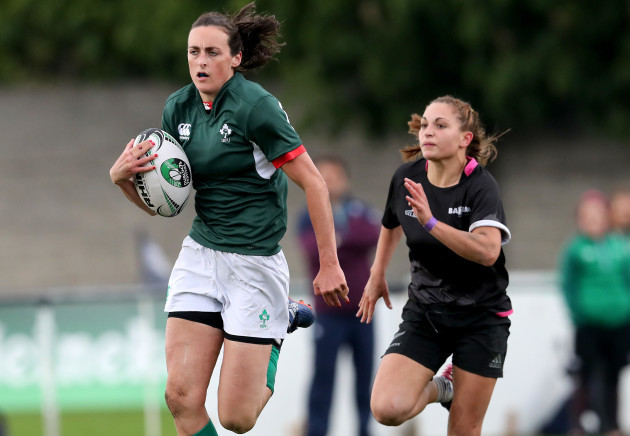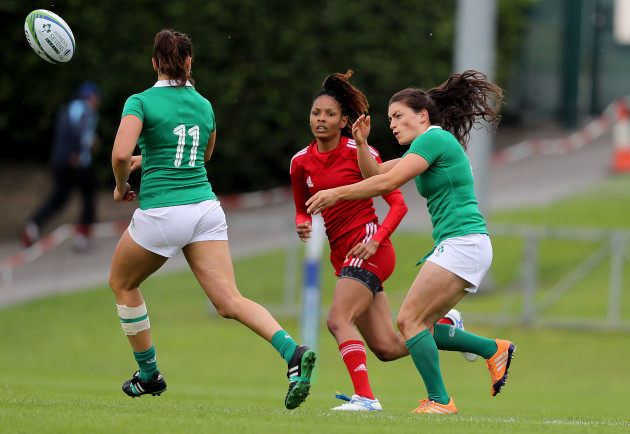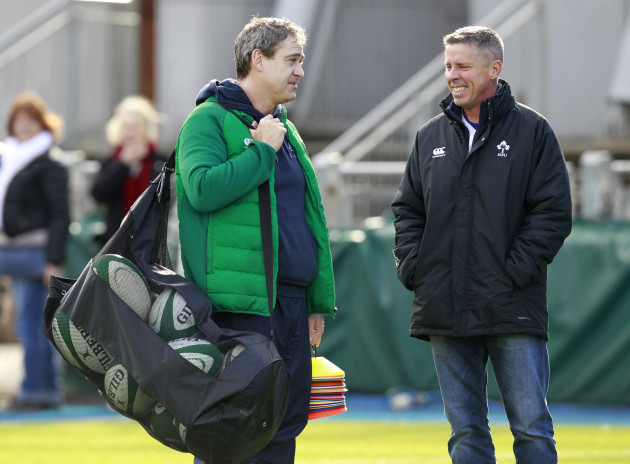‘THEY ARE DIFFERENT games and there’s different ways of playing them, but I love playing both.’
Hannah Tyrell ought to be made the face of IRFU’s women’s development plan.
An inter-county footballer, the Dubliner was recruited to play Sevens rugby three years ago. As a club member with Old Belvedere, she travelled to the 2014 World Cup in Marcoussis as a supporter, roaring out her lungs as Ireland defeated the Black Ferns and reached the final four.
Three years later, the 6’1” Tyrell is a powerful element of Ireland’s back three, a key portion of the weaponry that helped Ireland to push the professional world champion outfit of England as far as a brutally tough Grand Slam decider.
Tyrell’s GAA roots still shine through when she rises to collect high hanging cross-kicks and Garryowens, or when she steps up to take over goal-kicking duty of the oval ball. However, her pathway from Round Towers to the World Cup was paved by a Sevens programme that exposed her to an environment where high-intensity matches provided constant tests for skill-sets.
Women’s rugby director (and Sevens head coach) Anthony Eddy has placed a lot of stock in the value of the short form of the game to prepare players for 15-a-side.
Not without criticism either. A storm circled the women’s Six Nations campaign as Tyrell, Sene Naoupu and Alison Miller were deployed on Sevens duty in Las Vegas rather than facing France at home in February. The disquiet arising from the open letter circulated by ‘frustrated supporters of women’s rugby’ raised many valid points and created a conversation about the game well worth having.
“This was part of the high performance plan made several months ago and (Tierney) was well aware of it, he is fine with it and fully understands it,” Eddy said at the time.
This month will go a long way to vindicating or disproving Eddy’s cross-code approach. Ireland have nine players in their tournament 28 who are regulars on the Sevens circuit and the hope is that their on and off-field experiences can fuel a successful home World Cup.
Off-field: with their regular experience of being cooped up in camp and preparing to play matches in extremely tight windows.
On-field, tangibly: by adding their skills and athleticism to the mix in a tournament that is sure to reward teams capable of raiding space and passing around defences through improvisation as well as by pre-planned set plays.
“If you looked at a tournament for example,” Eddy tells The42 in a Lansdowne Road team room while citing analytics that would back him up, “the players in a Sevens tournament will have a greater involvement in a game compared to a 15s game.
They might throw anywhere from 30 to 50 passes over a weekend, compared to four or five or none in some instances (in a 15-a-side match).
“There’s a larger amount of tackles to be made in a Sevens tournament, a hell of a lot more decisions to make: ‘should I pass? Should I run?’
“And then there’s the contact component of the game. It is a physical game. Sevens isn’t what it was 15 years ago, it’s a very physical, confrontational game, so you have to be an outstanding defender and very good at the actual tackle contact for both attack and defence.
“It’s developing those skills so that they become a better sevens player and they could also progress to play 15s. It’s making them a better 15s player already as a result of doing things at a high intensity in that environment. It’s much more intense than a training session.
“Our players have been our greatest advocates and our greatest supporters. They certainly see the benefits of what the progamme has done over the last couple of years.”
The Australian adds: “It’s good learning for the players as well (facing different opponents) the adaptability and flexibility they have to show during a tournament, moving from one game to the next… to be able to recover from one game to the next and then to be able to do it from day to day. It’s a valuable tool for players to learn to be professional athletes.”
As Eddy points out, the players themselves have never shown much displeasure in the dual focus between short and long forms of the game. That owes no small amount of thanks to the rapid rate of improvement in the team’s performance. This season Eddy’s squad rose to ninth in the elite level World Series, secured qualification for next summer’s World Cup and also broke their duck against the powerhouses of England and Fiji along the way.
Not that it’s all sweetness and smiles of course.
“(Russia) is probably the one we all dread the most,” says Tyrell with a smile after a second place finish in Kazan.
“But the aim was to qualify for the World Cup and we achieved that.”
Eddy’s plans and projections haven’t missed the mark much since he took charge in 2014, here’s hoping his method is proven right when we see Ireland in action between August 9 and 26.
The42 is on Instagram! Tap the button below on your phone to follow us!



